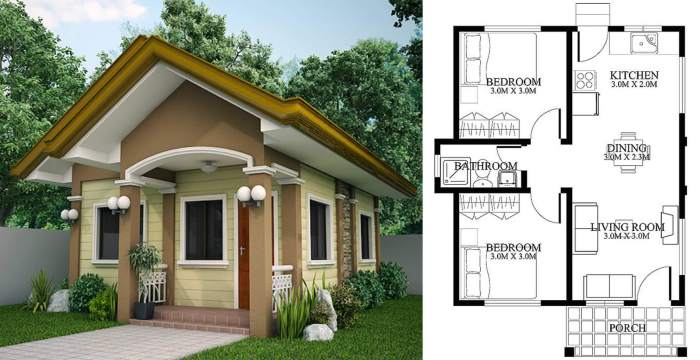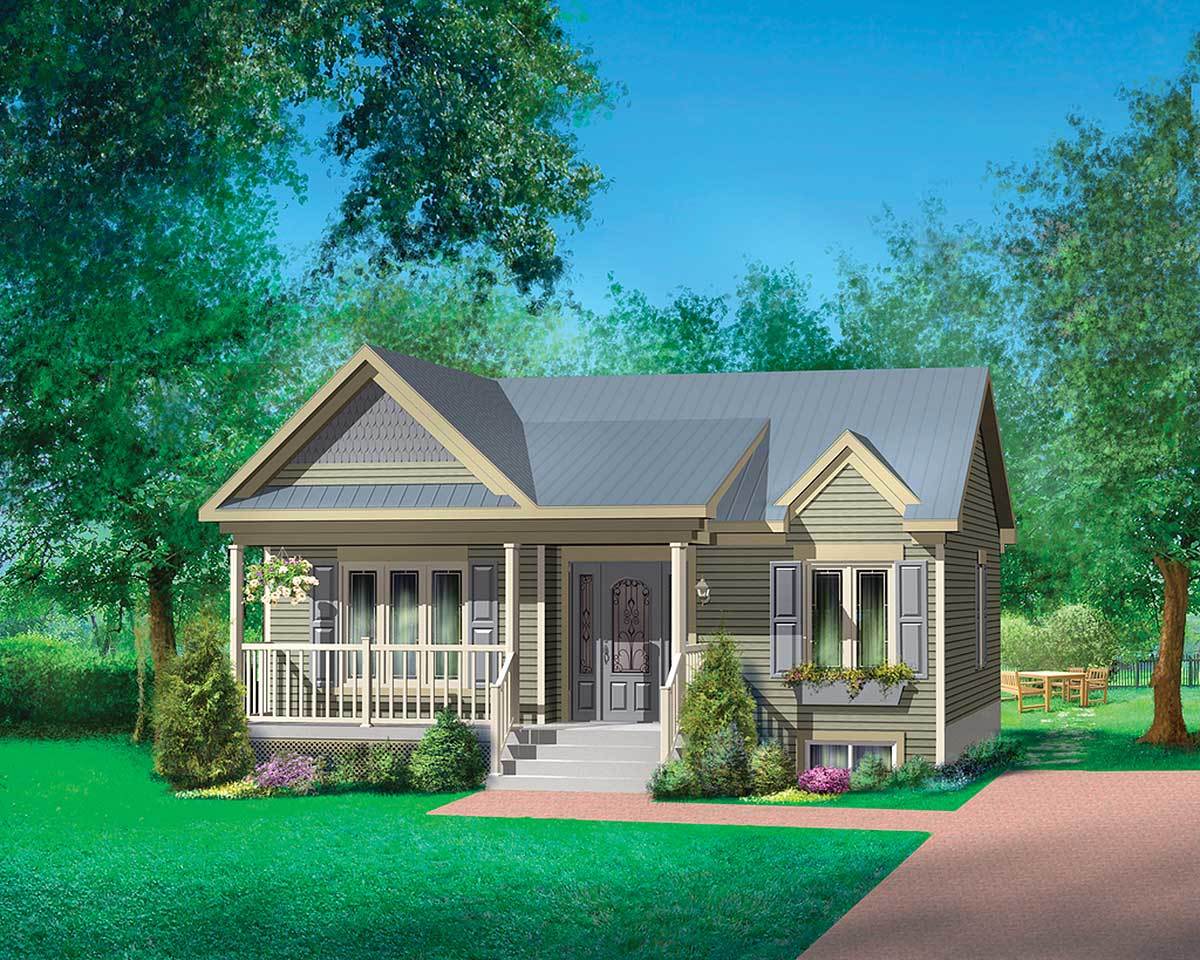Budget-Friendly Building Materials and Techniques: Small House Design With 2 Bedrooms

Small house design with 2 bedrooms – Constructing a small two-bedroom house on a budget requires careful consideration of materials and building methods. Choosing cost-effective options without sacrificing quality is achievable through strategic planning and the selection of appropriate materials and techniques. This section Artikels three budget-friendly materials and discusses alternative construction techniques to minimize costs.
Efficient space planning is crucial in small house designs with two bedrooms. Clever storage solutions are key, and a well-designed wardrobe can significantly impact a room’s functionality. For inspiration on maximizing your closet space, check out this guide on wardrobe design for bedroom ; incorporating these ideas into your small house plan will ensure both bedrooms feel spacious and organized.
Ultimately, thoughtful wardrobe design contributes to the overall success of a compact, comfortable home.
Cost-Effective Building Materials
The selection of building materials significantly impacts the overall project cost. Using readily available and less expensive materials can lead to considerable savings without compromising the structural integrity or aesthetic appeal of the house.
| Material | Cost per Unit | Quantity Needed (Estimate for a small 2-bedroom house) | Total Cost (Estimate) |
|---|---|---|---|
| Engineered Wood I-Joists | $15-$25 per linear foot | Approximately 500 linear feet | $7,500 – $12,500 |
| Oriented Strand Board (OSB) | $10-$15 per sheet (4’x8′) | Approximately 100 sheets | $1,000 – $1,500 |
| Concrete Blocks (CMU) | $1-$2 per block | Approximately 1000 blocks | $1,000 – $2,000 |
*Note: These cost estimates are approximate and can vary significantly based on location, supplier, and market conditions. These figures should be considered as a starting point for budgeting.*
Alternative Construction Techniques, Small house design with 2 bedrooms
Employing alternative construction techniques can further reduce costs without compromising the structural integrity and quality of the small two-bedroom house. These techniques often involve simpler designs and faster construction processes.One effective technique is to utilize prefabricated components. Prefabricated walls, roof trusses, and other elements can be manufactured off-site, reducing labor costs and construction time. This approach can significantly lower overall expenses compared to traditional on-site construction.
For example, a prefabricated wall section might cost $100 per square foot compared to $150-$200 per square foot for on-site construction. The savings are amplified in larger projects.Another approach is to simplify the design. A straightforward, rectangular design minimizes complex angles and cuts, reducing material waste and labor hours. This also reduces the complexity of the foundation, further reducing costs.
For instance, a simpler roof design might require fewer materials and less specialized labor compared to a more intricate, multi-gabled roof.
Smart Home Technology Integration

Smart home technology offers significant advantages in maximizing the functionality and efficiency of a small 2-bedroom house. By strategically integrating smart devices, homeowners can create a more comfortable, convenient, and energy-efficient living environment, even within limited square footage. This section will explore how to effectively utilize smart home technology in such a space.Smart home devices can significantly enhance various aspects of daily living in a small home.
Their compact nature and ability to automate tasks are particularly beneficial in maximizing limited space and minimizing clutter. Careful consideration of device placement is key to seamless integration and optimal functionality.
Smart Home Devices for Small Spaces
The following smart home devices are particularly well-suited for small 2-bedroom houses due to their space-saving designs and ability to improve functionality.
- Smart Lighting: Smart bulbs offer significant advantages in small spaces. Their ability to be controlled remotely and scheduled allows for optimized lighting based on occupancy and time of day, reducing energy waste and improving ambiance. For example, a smart bulb in the living room could automatically dim at sunset, creating a relaxing atmosphere while saving energy. Similarly, smart switches can control multiple lights simultaneously, streamlining operation.
- Smart Thermostat: A smart thermostat learns your heating and cooling preferences, automatically adjusting the temperature based on your schedule and occupancy. This feature leads to significant energy savings, particularly in smaller homes where temperature changes are felt more quickly. For instance, the thermostat could lower the temperature when you are away at work and raise it before your return, ensuring comfort without unnecessary energy consumption.
- Smart Speakers with Voice Assistants: Voice-activated assistants are invaluable in small spaces, allowing for hands-free control of various smart home devices. A single device can manage lighting, temperature, and even play music, eliminating the need for multiple remotes or apps. Imagine using voice commands to turn off the lights throughout the house before bed, enhancing convenience and simplifying daily routines.
- Smart Security System: A compact, wireless smart security system with door/window sensors and a security camera offers peace of mind without cluttering the space. Real-time alerts on your smartphone provide immediate notification of any unusual activity, enhancing security without the need for bulky, traditional security systems. For example, a motion sensor placed in the living room could alert you to any unexpected movement while you are away.
Integrating Smart Home Technology into a Floor Plan
Effective integration of smart home technology requires careful planning and consideration of device placement to maximize functionality and minimize visual clutter. The following illustrates a possible integration strategy for a typical 2-bedroom house.Consider a 2-bedroom house with an open-plan living/kitchen area. A smart thermostat could be centrally located on a wall in the living area for optimal temperature regulation.
Smart bulbs could be installed in all light fixtures throughout the house. A smart speaker could be positioned in the living area, serving as a central control hub for other smart devices. Smart plugs could be used for appliances in the kitchen to monitor energy consumption and remotely control devices. Door and window sensors could be installed on all exterior doors and windows, integrated with a smart security system and monitored via a smartphone app.
A security camera could be strategically placed to cover the main entrance or a common area. This setup allows for centralized control and monitoring of various aspects of the home’s functionality and security, all managed from a single app or voice commands.
FAQ Insights
What are some common challenges of designing a small 2-bedroom house?
Common challenges include maximizing storage, ensuring adequate natural light and ventilation, and creating a sense of spaciousness despite the limited square footage. Balancing functionality with aesthetics is also crucial.
How can I make a small 2-bedroom house feel larger?
Use light colors, maximize natural light, employ vertical storage solutions, and choose furniture with clean lines and minimal bulk. Mirrors can also create the illusion of more space.
What are some energy-efficient options for a small 2-bedroom house?
Consider energy-efficient appliances, proper insulation, high-performance windows, and potentially solar panels to reduce energy consumption and utility bills.

